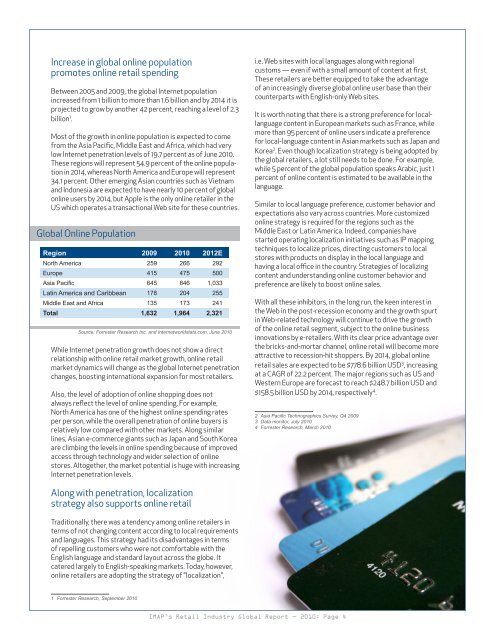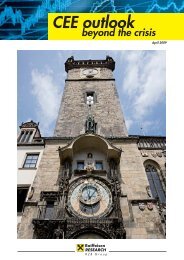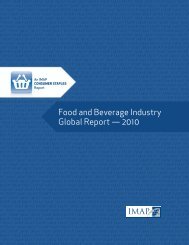Retail Industry Global Report — 2010 - Ascendant Capital Advisors
Retail Industry Global Report — 2010 - Ascendant Capital Advisors
Retail Industry Global Report — 2010 - Ascendant Capital Advisors
Create successful ePaper yourself
Turn your PDF publications into a flip-book with our unique Google optimized e-Paper software.
Increase in global online population<br />
promotes online retail spending<br />
Between 2005 and 2009, the global Internet population<br />
increased from 1 billion to more than 1.6 billion and by 2014 it is<br />
projected to grow by another 42 percent, reaching a level of 2.3<br />
billion 1 .<br />
Most of the growth in online population is expected to come<br />
from the Asia Pacific, Middle East and Africa, which had very<br />
low Internet penetration levels of 19.7 percent as of June <strong>2010</strong>.<br />
These regions will represent 54.9 percent of the online population<br />
in 2014, whereas North America and Europe will represent<br />
34.1 percent. Other emerging Asian countries such as Vietnam<br />
and Indonesia are expected to have nearly 10 percent of global<br />
online users by 2014, but Apple is the only online retailer in the<br />
US which operates a transactional Web site for these countries.<br />
<strong>Global</strong> Online Population<br />
Region 2009 <strong>2010</strong> 2012E<br />
North America 259 266 292<br />
Europe 415 475 500<br />
Asia Pacific 645 846 1,033<br />
Latin America and Caribbean 178 204 255<br />
Middle East and Africa 135 173 241<br />
Total 1,632 1,964 2,321<br />
Source: Forrester Research Inc. and Internetworldstats.com, June <strong>2010</strong><br />
While Internet penetration growth does not show a direct<br />
relationship with online retail market growth, online retail<br />
market dynamics will change as the global Internet penetration<br />
changes, boosting international expansion for most retailers.<br />
Also, the level of adoption of online shopping does not<br />
always reflect the level of online spending. For example,<br />
North America has one of the highest online spending rates<br />
per person, while the overall penetration of online buyers is<br />
relatively low compared with other markets. Along similar<br />
lines, Asian e-commerce giants such as Japan and South Korea<br />
are climbing the levels in online spending because of improved<br />
access through technology and wider selection of online<br />
stores. Altogether, the market potential is huge with increasing<br />
Internet penetration levels.<br />
Along with penetration, localization<br />
strategy also supports online retail<br />
Traditionally, there was a tendency among online retailers in<br />
terms of not changing content according to local requirements<br />
and languages. This strategy had its disadvantages in terms<br />
of repelling customers who were not comfortable with the<br />
English language and standard layout across the globe. It<br />
catered largely to English-speaking markets. Today, however,<br />
online retailers are adopting the strategy of "localization",<br />
1 Forrester Research, September <strong>2010</strong><br />
i.e. Web sites with local languages along with regional<br />
customs <strong>—</strong> even if with a small amount of content at first.<br />
These retailers are better equipped to take the advantage<br />
of an increasingly diverse global online user base than their<br />
counterparts with English-only Web sites.<br />
It is worth noting that there is a strong preference for locallanguage<br />
content in European markets such as France, while<br />
more than 95 percent of online users indicate a preference<br />
for local-language content in Asian markets such as Japan and<br />
Korea 2 . Even though localization strategy is being adopted by<br />
the global retailers, a lot still needs to be done. For example,<br />
while 5 percent of the global population speaks Arabic, just 1<br />
percent of online content is estimated to be available in the<br />
language.<br />
Similar to local language preference, customer behavior and<br />
expectations also vary across countries. More customized<br />
online strategy is required for the regions such as the<br />
Middle East or Latin America. Indeed, companies have<br />
started operating localization initiatives such as IP mapping<br />
techniques to localize prices, directing customers to local<br />
stores with products on display in the local language and<br />
having a local office in the country. Strategies of localizing<br />
content and understanding online customer behavior and<br />
preference are likely to boost online sales.<br />
With all these inhibitors, in the long run, the keen interest in<br />
the Web in the post-recession economy and the growth spurt<br />
in Web-related technology will continue to drive the growth<br />
of the online retail segment, subject to the online business<br />
innovations by e-retailers. With its clear price advantage over<br />
the bricks-and-mortar channel, online retail will become more<br />
attractive to recession-hit shoppers. By 2014, global online<br />
retail sales are expected to be $778.6 billion USD 3 , increasing<br />
at a CAGR of 22.2 percent. The major regions such as US and<br />
Western Europe are forecast to reach $248.7 billion USD and<br />
$158.5 billion USD by 2014, respectively 4 .<br />
2 Asia Pacific Technographics Survey, Q4 2009<br />
3 Data monitor, July <strong>2010</strong><br />
4 Forrester Research, March <strong>2010</strong><br />
IMAP’s <strong>Retail</strong> <strong>Industry</strong> <strong>Global</strong> <strong>Report</strong> <strong>—</strong> <strong>2010</strong>: Page 4







